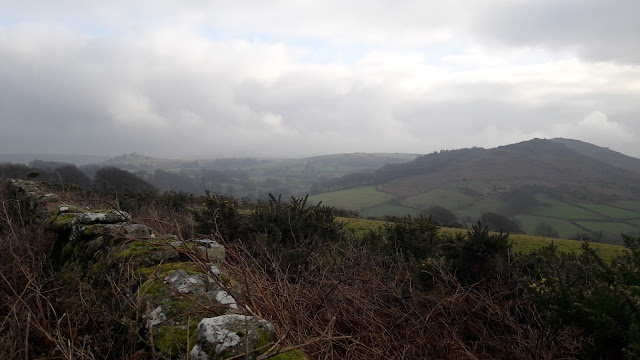 |
| Various usnea lichens |
 |
| String-of-sausages lichen |
 |
| Jew's ear (or jelly ear) fungus with frost |
In the
depths of January, on those days when there’s so little light from the sky, my
eye goes seeking out brightness in other places. It’s a turgid, murky day, the kind the locals
call ‘dimpsey.’ But there is colour
everywhere if you look carefully enough.
When
there’s the merest hint of winter sunshine, blackthorns, a deep burnt burgundy
a shade away from black, reveal the origin of their name. When the grey hand of clouds slides over,
flattening the light, these thorns appear truly black. Dead bracken stems glow a ferrous shade of
orange, especially on the gloomiest day.
The
unfortunately named jew’s ear fungus that grows on dead or dying elders changes
texture depending on the amount of rainfall, altering with a little sunlight from
a slobbery mess to a taut umbrella with the depthless velvety sheen of mid-denier
tights. It’s one of the few fungi that
will tolerate sub-zero temperatures without turning to mush; this morning
several of its ears were fringed with frost.
These
purples, oranges and browns are pleasing to the eye, but mostly mine seeks
green. ‘Wintergreen’ is an evocative
term that traditionally meant what we now call ‘evergreen’ – pine, holly,
ivy. Those trees, retaining their
chlorophyll year-round in glossy, hardy envelopes, are dependable in their
umbrous shades of dark green.
What is
more satisfying is the other, more subtle greens that surprise the eye and
appear to glow: the damp rubbery discs of pennywort; ferns, crisp and brittle
but still verdant. The cool, moist,
springy banks of emerald tamarisk moss in which you can hide a hand. Patches of forest star moss like verdant
islands in a granite-grey sea, their fruiting bodies extending like drooping brown
palms. All of them performing that magical
transmutation of sunlight into energy, even when the former seems nothing more
than a memory.
The
strangest hues of green are provided by lichens. Winter is when they come into their own, revealed
by the lack of leaves on the trees. They
seem to glow in poor light, like the luminous green stickers of childhood, and
the low sky picks out their presence like the cave of dark under a bunk bed. Map lichen, a lurid yellowish green layer
spread thinly on the granite, looks like a child’s version of islands, coloured
in with a day-glo marker and edged with black fine-liner.
The bare
branches of deciduous trees are bearded with string-of-sausages lichen and
encrustations of related species like twigs of coral in the soupy light. The coral comparison is apt, because like
corals, lichens are the product of a symbiotic relationship between different guilds
of life. In the case of lichens, it’s
between an alga and a fungus. The fungus
provides structure and the plant cells enable the lichen to photosynthesise –
hence the uncanny glaucous shades.
Usnea articulata or string-of-sausages is my favourite. It’s a scarce bushy lichen that’s highly
characteristic of Dartmoor. It’s largely
confined to the south west of England, with a few sites in Wales. It’s only found in humid climates with clean
air and abundant rain. The thalli (the
stem-like parts that give the lichen its shape) are long and tubular, and
pinched in at the joins like old fashioned butchers’ sausages. Articulated - hence the scientific name.
Beyond
these, the strands narrow to a blur of fine tendrils that tangle one into
another and ensnare raindrops. If
allowed to grow undisturbed, they hang long and loose in dangling tufts that
billow in the wind and sometimes tug down branches in a gale. Every part of the organism is an unvarying
pale grey-green. Against blue sky it’s delightful, and
against a more typical Dartmoor murk positively eldritch, especially when
viewed through twisted oaks among tumbling moss-covered boulders.
Once, when
exploring some ruined farm buildings with my children in early spring, a mistle
thrush slipped quietly away from a sycamore that was draped in cascades of
string-of-sausages lichen. We climbed onto
a wall to inspect the branch the bird had flown from, and, parting the curtains,
found another world. An immaculate nest containing
four pale blue eggs speckled with brown, screened on all sides by drifts of glacial
green lichen. It felt like voyeurism,
and we left as quickly as we could.




































